BEd F-WIL 101: Workplace Learning Guidelines for Mentor Teachers
VerifiedAdded on 2023/06/09
|52
|15490
|460
Practical Assignment
AI Summary
This document provides guidelines for mentor teachers involved in the Workplace Integrated Learning (WIL) program for Bachelor of Education (BEd) Foundation Phase student teachers. It outlines the rationale for WIL, the roles of various participants (student teacher, mentor teacher, and SANTS WIL assessor), and an overview of the student teacher's program during the five-week WIL period. The guidelines detail the responsibilities and expectations of mentor teachers, including providing support, guidance, and feedback to student teachers. It includes information on reflection, health and safety, and student deliverables, such as the Portfolio of Evidence (PoE). The document also provides various addenda, including templates for lesson planning, learner observation, reflection, and assessment rubrics, designed to support both mentor teachers and student teachers throughout the WIL experience. This resource aims to facilitate a smooth transition for student teachers into the teaching profession. Desklib provides additional resources like past papers and solved assignments for students.
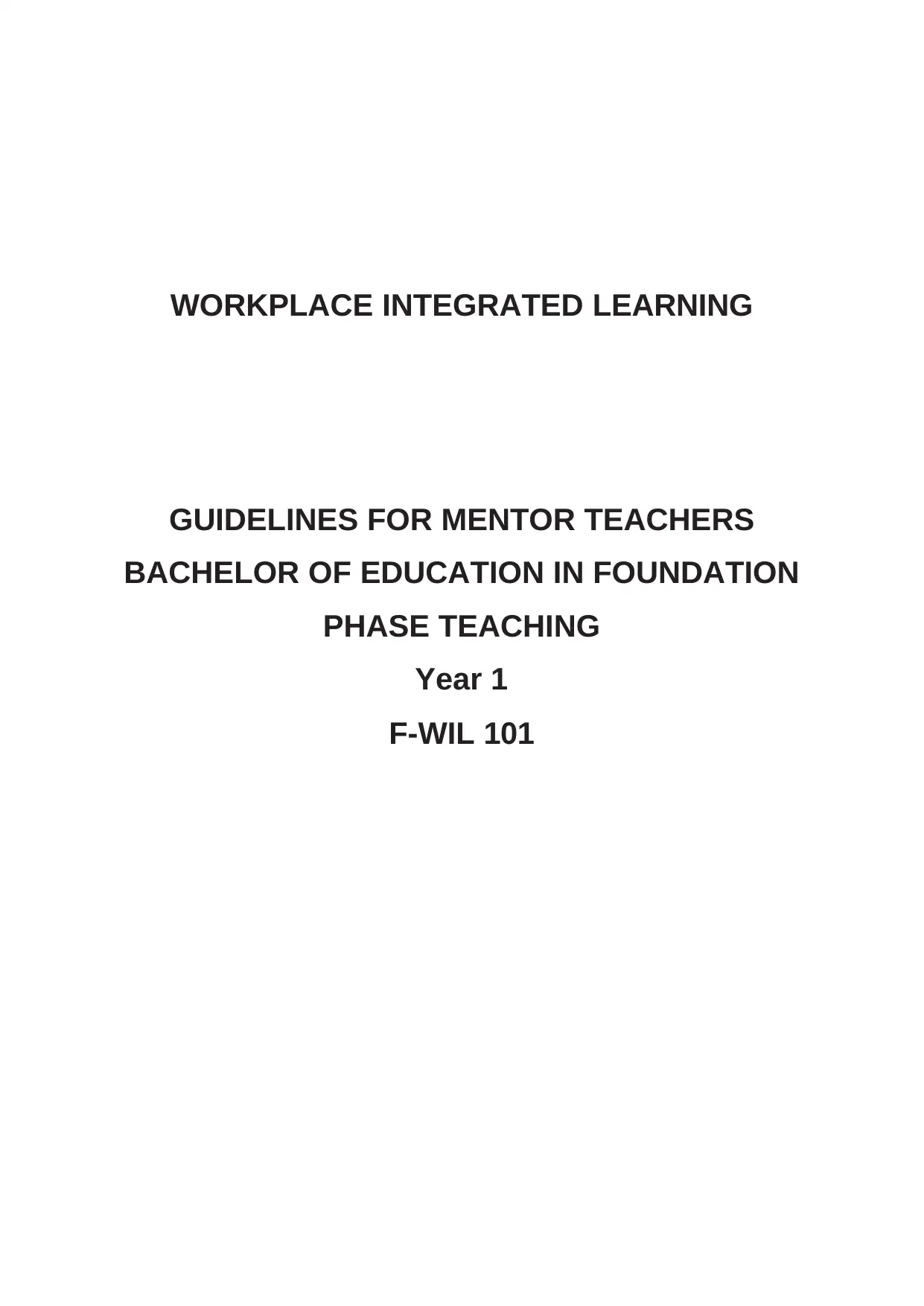
WORKPLACE INTEGRATED LEARNING
GUIDELINES FOR MENTOR TEACHERS
BACHELOR OF EDUCATION IN FOUNDATION
PHASE TEACHING
Year 1
F-WIL 101
GUIDELINES FOR MENTOR TEACHERS
BACHELOR OF EDUCATION IN FOUNDATION
PHASE TEACHING
Year 1
F-WIL 101
Paraphrase This Document
Need a fresh take? Get an instant paraphrase of this document with our AI Paraphraser
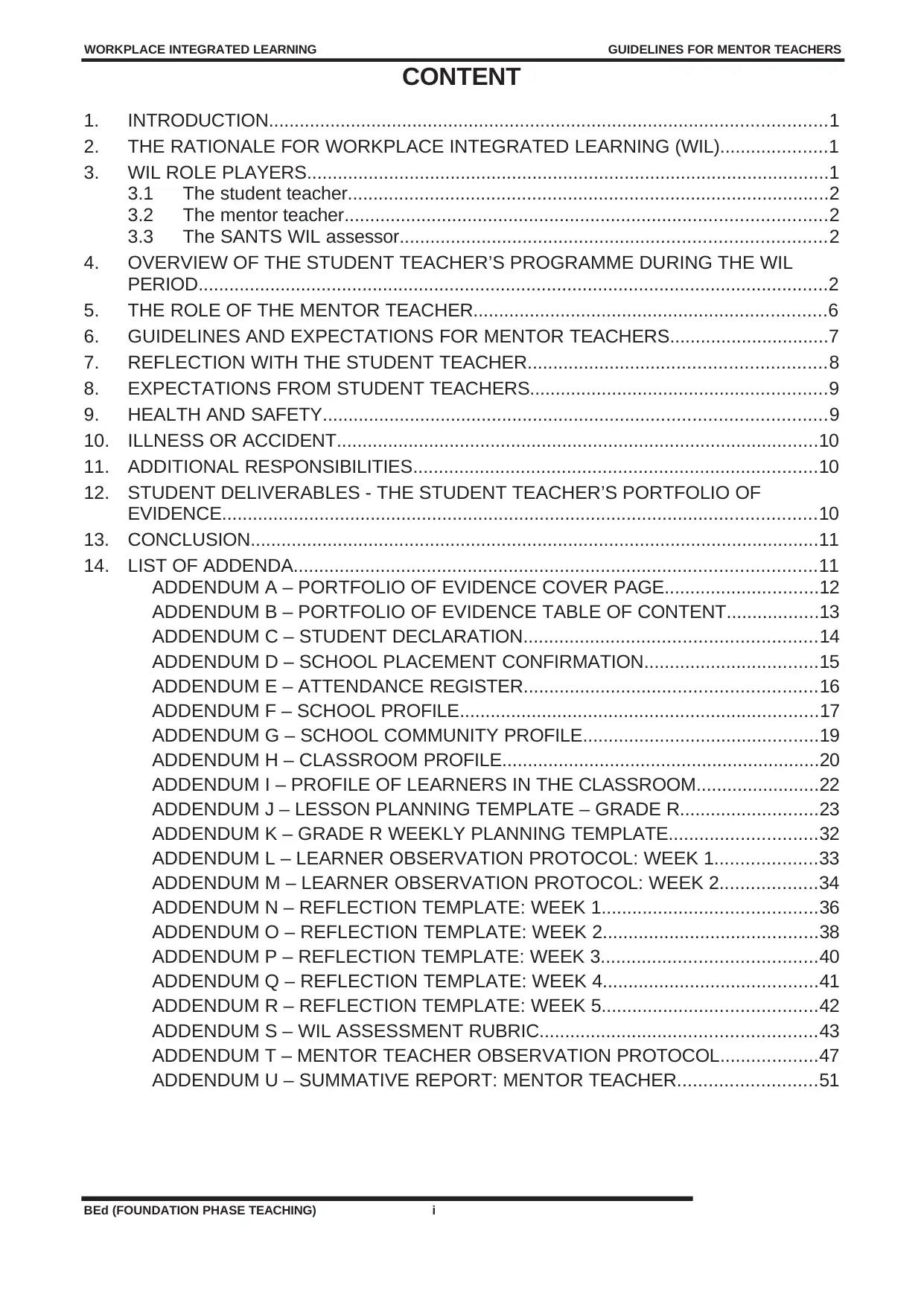
BEd (FOUNDATION PHASE TEACHING) i
WORKPLACE INTEGRATED LEARNING GUIDELINES FOR MENTOR TEACHERS
CONTENT
1. INTRODUCTION.............................................................................................................1
2. THE RATIONALE FOR WORKPLACE INTEGRATED LEARNING (WIL).....................1
3. WIL ROLE PLAYERS......................................................................................................1
3.1 The student teacher..............................................................................................2
3.2 The mentor teacher..............................................................................................2
3.3 The SANTS WIL assessor...................................................................................2
4. OVERVIEW OF THE STUDENT TEACHER’S PROGRAMME DURING THE WIL
PERIOD...........................................................................................................................2
5. THE ROLE OF THE MENTOR TEACHER.....................................................................6
6. GUIDELINES AND EXPECTATIONS FOR MENTOR TEACHERS...............................7
7. REFLECTION WITH THE STUDENT TEACHER..........................................................8
8. EXPECTATIONS FROM STUDENT TEACHERS..........................................................9
9. HEALTH AND SAFETY..................................................................................................9
10. ILLNESS OR ACCIDENT..............................................................................................10
11. ADDITIONAL RESPONSIBILITIES...............................................................................10
12. STUDENT DELIVERABLES - THE STUDENT TEACHER’S PORTFOLIO OF
EVIDENCE....................................................................................................................10
13. CONCLUSION...............................................................................................................11
14. LIST OF ADDENDA......................................................................................................11
ADDENDUM A – PORTFOLIO OF EVIDENCE COVER PAGE..............................12
ADDENDUM B – PORTFOLIO OF EVIDENCE TABLE OF CONTENT..................13
ADDENDUM C – STUDENT DECLARATION.........................................................14
ADDENDUM D – SCHOOL PLACEMENT CONFIRMATION..................................15
ADDENDUM E – ATTENDANCE REGISTER.........................................................16
ADDENDUM F – SCHOOL PROFILE......................................................................17
ADDENDUM G – SCHOOL COMMUNITY PROFILE..............................................19
ADDENDUM H – CLASSROOM PROFILE..............................................................20
ADDENDUM I – PROFILE OF LEARNERS IN THE CLASSROOM........................22
ADDENDUM J – LESSON PLANNING TEMPLATE – GRADE R...........................23
ADDENDUM K – GRADE R WEEKLY PLANNING TEMPLATE.............................32
ADDENDUM L – LEARNER OBSERVATION PROTOCOL: WEEK 1....................33
ADDENDUM M – LEARNER OBSERVATION PROTOCOL: WEEK 2...................34
ADDENDUM N – REFLECTION TEMPLATE: WEEK 1..........................................36
ADDENDUM O – REFLECTION TEMPLATE: WEEK 2..........................................38
ADDENDUM P – REFLECTION TEMPLATE: WEEK 3..........................................40
ADDENDUM Q – REFLECTION TEMPLATE: WEEK 4..........................................41
ADDENDUM R – REFLECTION TEMPLATE: WEEK 5..........................................42
ADDENDUM S – WIL ASSESSMENT RUBRIC......................................................43
ADDENDUM T – MENTOR TEACHER OBSERVATION PROTOCOL...................47
ADDENDUM U – SUMMATIVE REPORT: MENTOR TEACHER...........................51
WORKPLACE INTEGRATED LEARNING GUIDELINES FOR MENTOR TEACHERS
CONTENT
1. INTRODUCTION.............................................................................................................1
2. THE RATIONALE FOR WORKPLACE INTEGRATED LEARNING (WIL).....................1
3. WIL ROLE PLAYERS......................................................................................................1
3.1 The student teacher..............................................................................................2
3.2 The mentor teacher..............................................................................................2
3.3 The SANTS WIL assessor...................................................................................2
4. OVERVIEW OF THE STUDENT TEACHER’S PROGRAMME DURING THE WIL
PERIOD...........................................................................................................................2
5. THE ROLE OF THE MENTOR TEACHER.....................................................................6
6. GUIDELINES AND EXPECTATIONS FOR MENTOR TEACHERS...............................7
7. REFLECTION WITH THE STUDENT TEACHER..........................................................8
8. EXPECTATIONS FROM STUDENT TEACHERS..........................................................9
9. HEALTH AND SAFETY..................................................................................................9
10. ILLNESS OR ACCIDENT..............................................................................................10
11. ADDITIONAL RESPONSIBILITIES...............................................................................10
12. STUDENT DELIVERABLES - THE STUDENT TEACHER’S PORTFOLIO OF
EVIDENCE....................................................................................................................10
13. CONCLUSION...............................................................................................................11
14. LIST OF ADDENDA......................................................................................................11
ADDENDUM A – PORTFOLIO OF EVIDENCE COVER PAGE..............................12
ADDENDUM B – PORTFOLIO OF EVIDENCE TABLE OF CONTENT..................13
ADDENDUM C – STUDENT DECLARATION.........................................................14
ADDENDUM D – SCHOOL PLACEMENT CONFIRMATION..................................15
ADDENDUM E – ATTENDANCE REGISTER.........................................................16
ADDENDUM F – SCHOOL PROFILE......................................................................17
ADDENDUM G – SCHOOL COMMUNITY PROFILE..............................................19
ADDENDUM H – CLASSROOM PROFILE..............................................................20
ADDENDUM I – PROFILE OF LEARNERS IN THE CLASSROOM........................22
ADDENDUM J – LESSON PLANNING TEMPLATE – GRADE R...........................23
ADDENDUM K – GRADE R WEEKLY PLANNING TEMPLATE.............................32
ADDENDUM L – LEARNER OBSERVATION PROTOCOL: WEEK 1....................33
ADDENDUM M – LEARNER OBSERVATION PROTOCOL: WEEK 2...................34
ADDENDUM N – REFLECTION TEMPLATE: WEEK 1..........................................36
ADDENDUM O – REFLECTION TEMPLATE: WEEK 2..........................................38
ADDENDUM P – REFLECTION TEMPLATE: WEEK 3..........................................40
ADDENDUM Q – REFLECTION TEMPLATE: WEEK 4..........................................41
ADDENDUM R – REFLECTION TEMPLATE: WEEK 5..........................................42
ADDENDUM S – WIL ASSESSMENT RUBRIC......................................................43
ADDENDUM T – MENTOR TEACHER OBSERVATION PROTOCOL...................47
ADDENDUM U – SUMMATIVE REPORT: MENTOR TEACHER...........................51
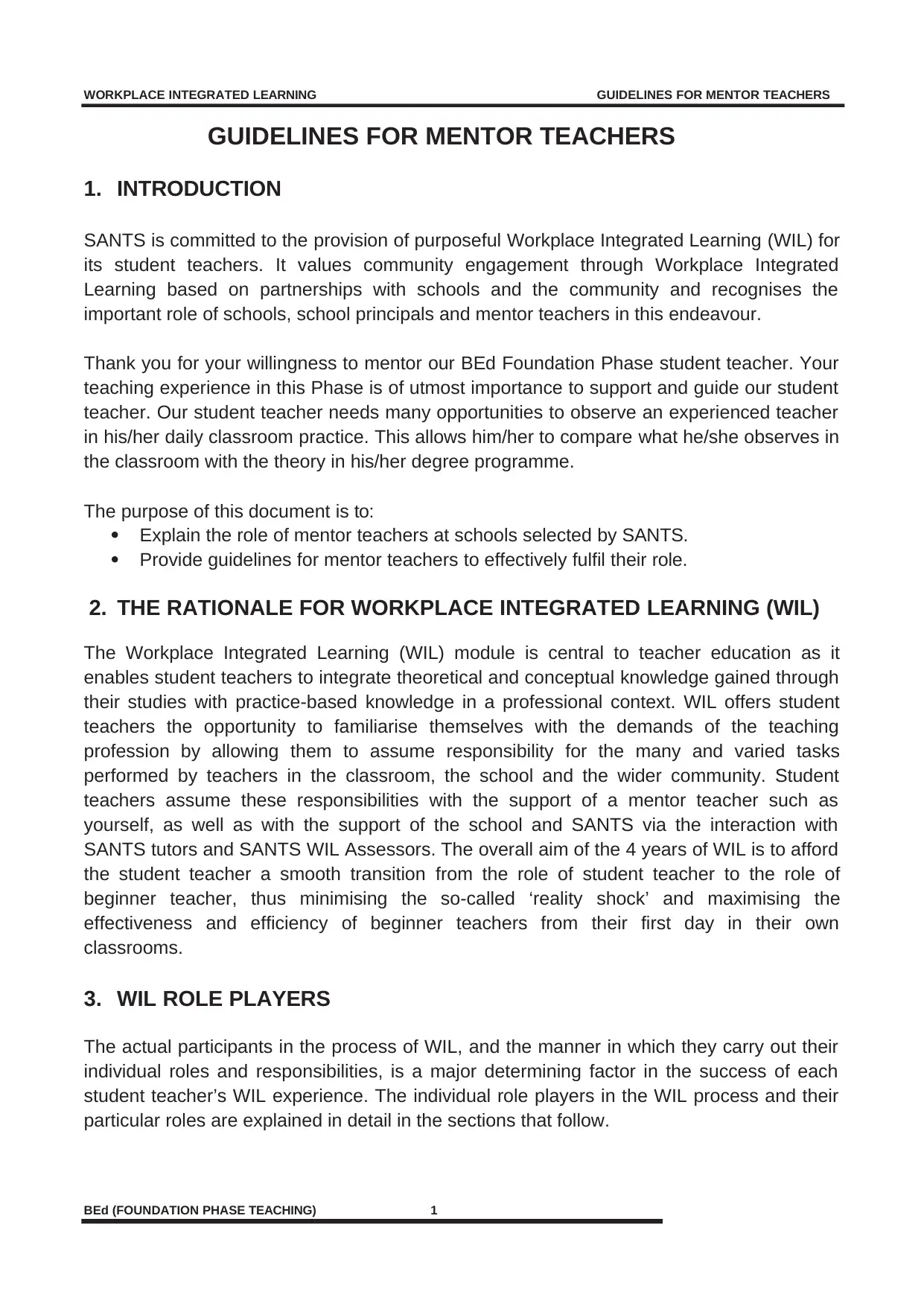
WORKPLACE INTEGRATED LEARNING GUIDELINES FOR MENTOR TEACHERS
BEd (FOUNDATION PHASE TEACHING) 1
GUIDELINES FOR MENTOR TEACHERS
1. INTRODUCTION
SANTS is committed to the provision of purposeful Workplace Integrated Learning (WIL) for
its student teachers. It values community engagement through Workplace Integrated
Learning based on partnerships with schools and the community and recognises the
important role of schools, school principals and mentor teachers in this endeavour.
Thank you for your willingness to mentor our BEd Foundation Phase student teacher. Your
teaching experience in this Phase is of utmost importance to support and guide our student
teacher. Our student teacher needs many opportunities to observe an experienced teacher
in his/her daily classroom practice. This allows him/her to compare what he/she observes in
the classroom with the theory in his/her degree programme.
The purpose of this document is to:
Explain the role of mentor teachers at schools selected by SANTS.
Provide guidelines for mentor teachers to effectively fulfil their role.
2. THE RATIONALE FOR WORKPLACE INTEGRATED LEARNING (WIL)
The Workplace Integrated Learning (WIL) module is central to teacher education as it
enables student teachers to integrate theoretical and conceptual knowledge gained through
their studies with practice-based knowledge in a professional context. WIL offers student
teachers the opportunity to familiarise themselves with the demands of the teaching
profession by allowing them to assume responsibility for the many and varied tasks
performed by teachers in the classroom, the school and the wider community. Student
teachers assume these responsibilities with the support of a mentor teacher such as
yourself, as well as with the support of the school and SANTS via the interaction with
SANTS tutors and SANTS WIL Assessors. The overall aim of the 4 years of WIL is to afford
the student teacher a smooth transition from the role of student teacher to the role of
beginner teacher, thus minimising the so-called ‘reality shock’ and maximising the
effectiveness and efficiency of beginner teachers from their first day in their own
classrooms.
3. WIL ROLE PLAYERS
The actual participants in the process of WIL, and the manner in which they carry out their
individual roles and responsibilities, is a major determining factor in the success of each
student teacher’s WIL experience. The individual role players in the WIL process and their
particular roles are explained in detail in the sections that follow.
BEd (FOUNDATION PHASE TEACHING) 1
GUIDELINES FOR MENTOR TEACHERS
1. INTRODUCTION
SANTS is committed to the provision of purposeful Workplace Integrated Learning (WIL) for
its student teachers. It values community engagement through Workplace Integrated
Learning based on partnerships with schools and the community and recognises the
important role of schools, school principals and mentor teachers in this endeavour.
Thank you for your willingness to mentor our BEd Foundation Phase student teacher. Your
teaching experience in this Phase is of utmost importance to support and guide our student
teacher. Our student teacher needs many opportunities to observe an experienced teacher
in his/her daily classroom practice. This allows him/her to compare what he/she observes in
the classroom with the theory in his/her degree programme.
The purpose of this document is to:
Explain the role of mentor teachers at schools selected by SANTS.
Provide guidelines for mentor teachers to effectively fulfil their role.
2. THE RATIONALE FOR WORKPLACE INTEGRATED LEARNING (WIL)
The Workplace Integrated Learning (WIL) module is central to teacher education as it
enables student teachers to integrate theoretical and conceptual knowledge gained through
their studies with practice-based knowledge in a professional context. WIL offers student
teachers the opportunity to familiarise themselves with the demands of the teaching
profession by allowing them to assume responsibility for the many and varied tasks
performed by teachers in the classroom, the school and the wider community. Student
teachers assume these responsibilities with the support of a mentor teacher such as
yourself, as well as with the support of the school and SANTS via the interaction with
SANTS tutors and SANTS WIL Assessors. The overall aim of the 4 years of WIL is to afford
the student teacher a smooth transition from the role of student teacher to the role of
beginner teacher, thus minimising the so-called ‘reality shock’ and maximising the
effectiveness and efficiency of beginner teachers from their first day in their own
classrooms.
3. WIL ROLE PLAYERS
The actual participants in the process of WIL, and the manner in which they carry out their
individual roles and responsibilities, is a major determining factor in the success of each
student teacher’s WIL experience. The individual role players in the WIL process and their
particular roles are explained in detail in the sections that follow.
⊘ This is a preview!⊘
Do you want full access?
Subscribe today to unlock all pages.

Trusted by 1+ million students worldwide
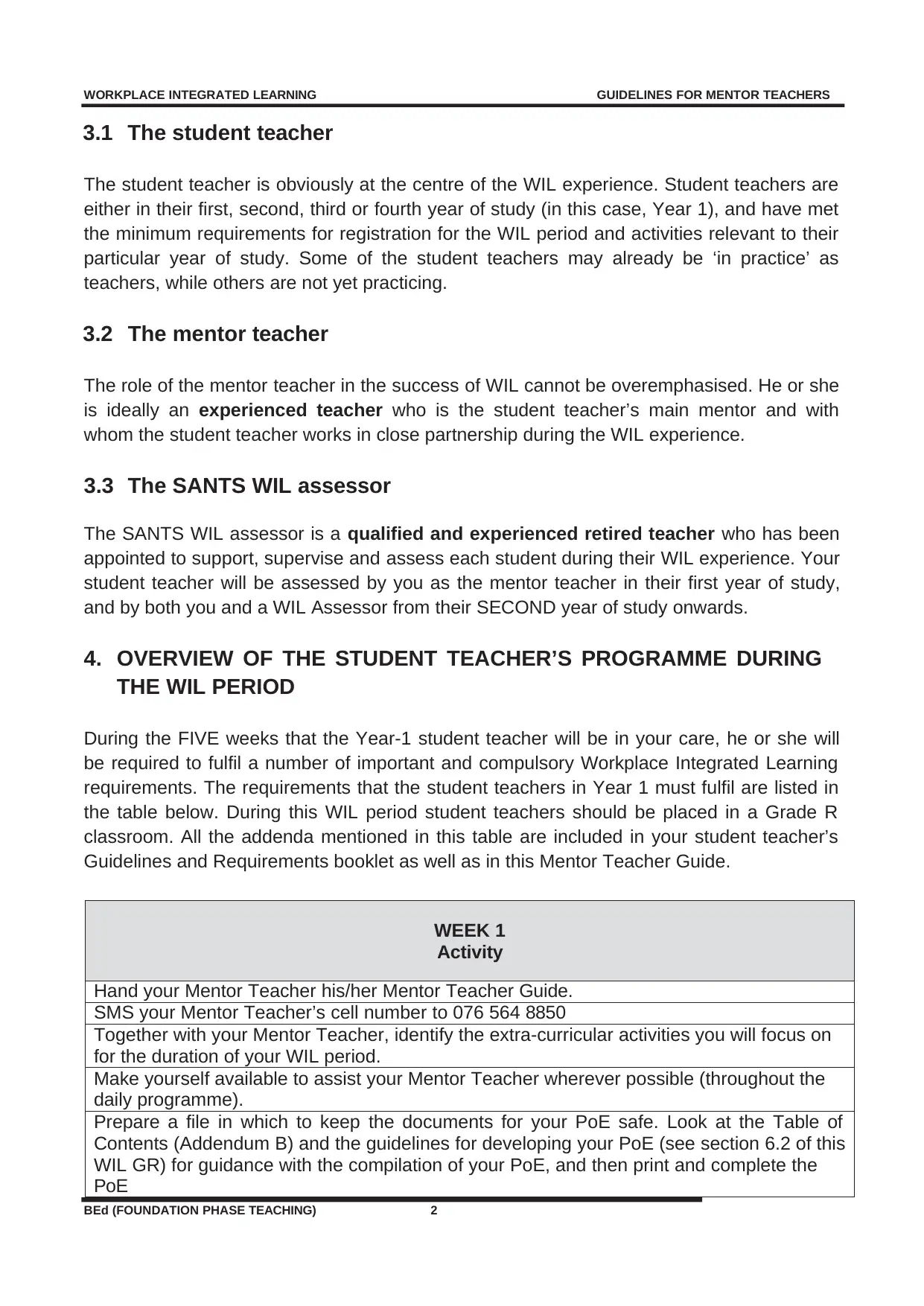
WORKPLACE INTEGRATED LEARNING GUIDELINES FOR MENTOR TEACHERS
BEd (FOUNDATION PHASE TEACHING) 2
3.1 The student teacher
The student teacher is obviously at the centre of the WIL experience. Student teachers are
either in their first, second, third or fourth year of study (in this case, Year 1), and have met
the minimum requirements for registration for the WIL period and activities relevant to their
particular year of study. Some of the student teachers may already be ‘in practice’ as
teachers, while others are not yet practicing.
3.2 The mentor teacher
The role of the mentor teacher in the success of WIL cannot be overemphasised. He or she
is ideally an experienced teacher who is the student teacher’s main mentor and with
whom the student teacher works in close partnership during the WIL experience.
3.3 The SANTS WIL assessor
The SANTS WIL assessor is a qualified and experienced retired teacher who has been
appointed to support, supervise and assess each student during their WIL experience. Your
student teacher will be assessed by you as the mentor teacher in their first year of study,
and by both you and a WIL Assessor from their SECOND year of study onwards.
4. OVERVIEW OF THE STUDENT TEACHER’S PROGRAMME DURING
THE WIL PERIOD
During the FIVE weeks that the Year-1 student teacher will be in your care, he or she will
be required to fulfil a number of important and compulsory Workplace Integrated Learning
requirements. The requirements that the student teachers in Year 1 must fulfil are listed in
the table below. During this WIL period student teachers should be placed in a Grade R
classroom. All the addenda mentioned in this table are included in your student teacher’s
Guidelines and Requirements booklet as well as in this Mentor Teacher Guide.
WEEK 1
Activity
Hand your Mentor Teacher his/her Mentor Teacher Guide.
SMS your Mentor Teacher’s cell number to 076 564 8850
Together with your Mentor Teacher, identify the extra-curricular activities you will focus on
for the duration of your WIL period.
Make yourself available to assist your Mentor Teacher wherever possible (throughout the
daily programme).
Prepare a file in which to keep the documents for your PoE safe. Look at the Table of
Contents (Addendum B) and the guidelines for developing your PoE (see section 6.2 of this
WIL GR) for guidance with the compilation of your PoE, and then print and complete the
PoE
BEd (FOUNDATION PHASE TEACHING) 2
3.1 The student teacher
The student teacher is obviously at the centre of the WIL experience. Student teachers are
either in their first, second, third or fourth year of study (in this case, Year 1), and have met
the minimum requirements for registration for the WIL period and activities relevant to their
particular year of study. Some of the student teachers may already be ‘in practice’ as
teachers, while others are not yet practicing.
3.2 The mentor teacher
The role of the mentor teacher in the success of WIL cannot be overemphasised. He or she
is ideally an experienced teacher who is the student teacher’s main mentor and with
whom the student teacher works in close partnership during the WIL experience.
3.3 The SANTS WIL assessor
The SANTS WIL assessor is a qualified and experienced retired teacher who has been
appointed to support, supervise and assess each student during their WIL experience. Your
student teacher will be assessed by you as the mentor teacher in their first year of study,
and by both you and a WIL Assessor from their SECOND year of study onwards.
4. OVERVIEW OF THE STUDENT TEACHER’S PROGRAMME DURING
THE WIL PERIOD
During the FIVE weeks that the Year-1 student teacher will be in your care, he or she will
be required to fulfil a number of important and compulsory Workplace Integrated Learning
requirements. The requirements that the student teachers in Year 1 must fulfil are listed in
the table below. During this WIL period student teachers should be placed in a Grade R
classroom. All the addenda mentioned in this table are included in your student teacher’s
Guidelines and Requirements booklet as well as in this Mentor Teacher Guide.
WEEK 1
Activity
Hand your Mentor Teacher his/her Mentor Teacher Guide.
SMS your Mentor Teacher’s cell number to 076 564 8850
Together with your Mentor Teacher, identify the extra-curricular activities you will focus on
for the duration of your WIL period.
Make yourself available to assist your Mentor Teacher wherever possible (throughout the
daily programme).
Prepare a file in which to keep the documents for your PoE safe. Look at the Table of
Contents (Addendum B) and the guidelines for developing your PoE (see section 6.2 of this
WIL GR) for guidance with the compilation of your PoE, and then print and complete the
PoE
Paraphrase This Document
Need a fresh take? Get an instant paraphrase of this document with our AI Paraphraser
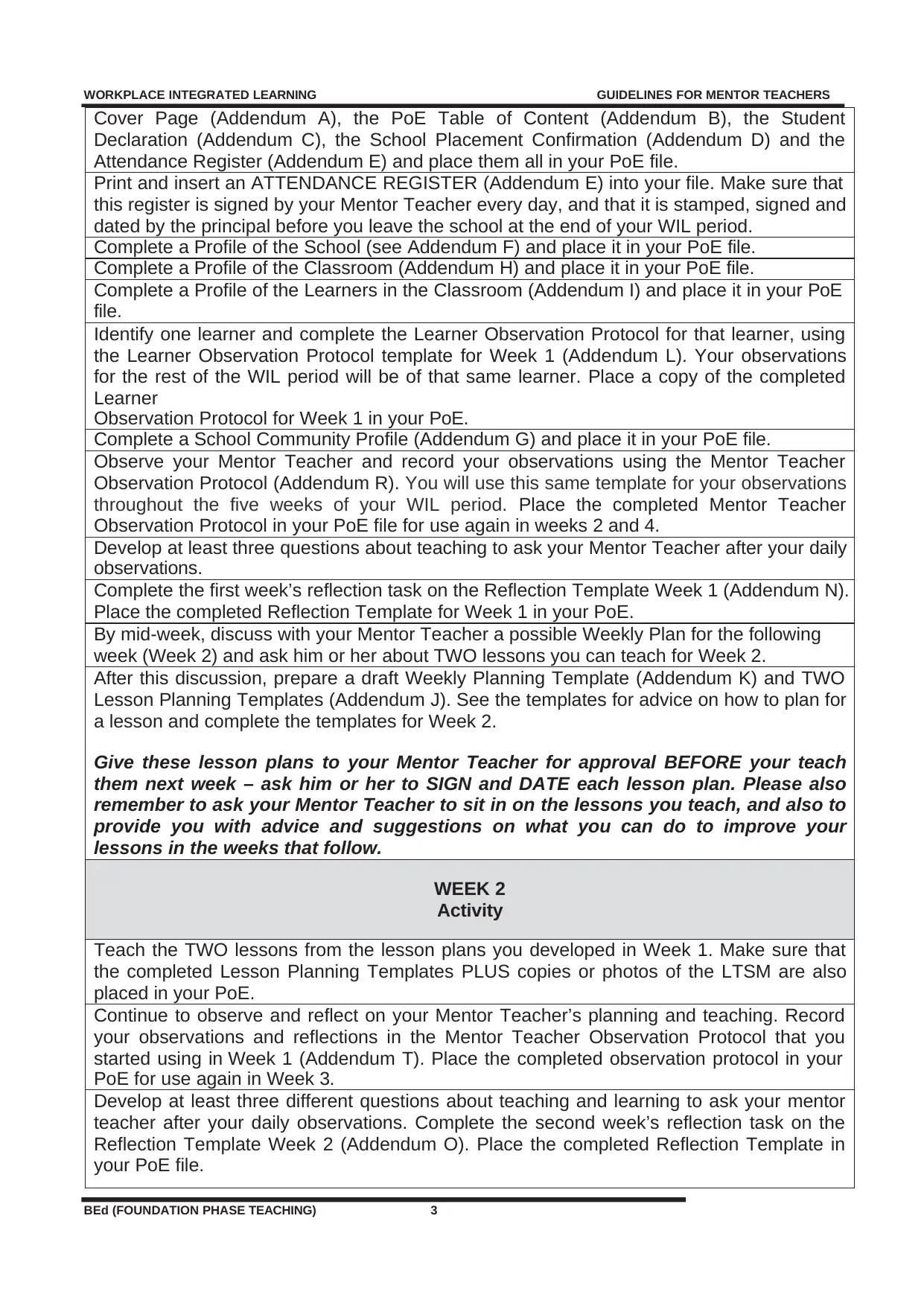
WORKPLACE INTEGRATED LEARNING GUIDELINES FOR MENTOR TEACHERS
BEd (FOUNDATION PHASE TEACHING) 3
Cover Page (Addendum A), the PoE Table of Content (Addendum B), the Student
Declaration (Addendum C), the School Placement Confirmation (Addendum D) and the
Attendance Register (Addendum E) and place them all in your PoE file.
Print and insert an ATTENDANCE REGISTER (Addendum E) into your file. Make sure that
this register is signed by your Mentor Teacher every day, and that it is stamped, signed and
dated by the principal before you leave the school at the end of your WIL period.
Complete a Profile of the School (see Addendum F) and place it in your PoE file.
Complete a Profile of the Classroom (Addendum H) and place it in your PoE file.
Complete a Profile of the Learners in the Classroom (Addendum I) and place it in your PoE
file.
Identify one learner and complete the Learner Observation Protocol for that learner, using
the Learner Observation Protocol template for Week 1 (Addendum L). Your observations
for the rest of the WIL period will be of that same learner. Place a copy of the completed
Learner
Observation Protocol for Week 1 in your PoE.
Complete a School Community Profile (Addendum G) and place it in your PoE file.
Observe your Mentor Teacher and record your observations using the Mentor Teacher
Observation Protocol (Addendum R). You will use this same template for your observations
throughout the five weeks of your WIL period. Place the completed Mentor Teacher
Observation Protocol in your PoE file for use again in weeks 2 and 4.
Develop at least three questions about teaching to ask your Mentor Teacher after your daily
observations.
Complete the first week’s reflection task on the Reflection Template Week 1 (Addendum N).
Place the completed Reflection Template for Week 1 in your PoE.
By mid-week, discuss with your Mentor Teacher a possible Weekly Plan for the following
week (Week 2) and ask him or her about TWO lessons you can teach for Week 2.
After this discussion, prepare a draft Weekly Planning Template (Addendum K) and TWO
Lesson Planning Templates (Addendum J). See the templates for advice on how to plan for
a lesson and complete the templates for Week 2.
Give these lesson plans to your Mentor Teacher for approval BEFORE your teach
them next week – ask him or her to SIGN and DATE each lesson plan. Please also
remember to ask your Mentor Teacher to sit in on the lessons you teach, and also to
provide you with advice and suggestions on what you can do to improve your
lessons in the weeks that follow.
WEEK 2
Activity
Teach the TWO lessons from the lesson plans you developed in Week 1. Make sure that
the completed Lesson Planning Templates PLUS copies or photos of the LTSM are also
placed in your PoE.
Continue to observe and reflect on your Mentor Teacher’s planning and teaching. Record
your observations and reflections in the Mentor Teacher Observation Protocol that you
started using in Week 1 (Addendum T). Place the completed observation protocol in your
PoE for use again in Week 3.
Develop at least three different questions about teaching and learning to ask your mentor
teacher after your daily observations. Complete the second week’s reflection task on the
Reflection Template Week 2 (Addendum O). Place the completed Reflection Template in
your PoE file.
BEd (FOUNDATION PHASE TEACHING) 3
Cover Page (Addendum A), the PoE Table of Content (Addendum B), the Student
Declaration (Addendum C), the School Placement Confirmation (Addendum D) and the
Attendance Register (Addendum E) and place them all in your PoE file.
Print and insert an ATTENDANCE REGISTER (Addendum E) into your file. Make sure that
this register is signed by your Mentor Teacher every day, and that it is stamped, signed and
dated by the principal before you leave the school at the end of your WIL period.
Complete a Profile of the School (see Addendum F) and place it in your PoE file.
Complete a Profile of the Classroom (Addendum H) and place it in your PoE file.
Complete a Profile of the Learners in the Classroom (Addendum I) and place it in your PoE
file.
Identify one learner and complete the Learner Observation Protocol for that learner, using
the Learner Observation Protocol template for Week 1 (Addendum L). Your observations
for the rest of the WIL period will be of that same learner. Place a copy of the completed
Learner
Observation Protocol for Week 1 in your PoE.
Complete a School Community Profile (Addendum G) and place it in your PoE file.
Observe your Mentor Teacher and record your observations using the Mentor Teacher
Observation Protocol (Addendum R). You will use this same template for your observations
throughout the five weeks of your WIL period. Place the completed Mentor Teacher
Observation Protocol in your PoE file for use again in weeks 2 and 4.
Develop at least three questions about teaching to ask your Mentor Teacher after your daily
observations.
Complete the first week’s reflection task on the Reflection Template Week 1 (Addendum N).
Place the completed Reflection Template for Week 1 in your PoE.
By mid-week, discuss with your Mentor Teacher a possible Weekly Plan for the following
week (Week 2) and ask him or her about TWO lessons you can teach for Week 2.
After this discussion, prepare a draft Weekly Planning Template (Addendum K) and TWO
Lesson Planning Templates (Addendum J). See the templates for advice on how to plan for
a lesson and complete the templates for Week 2.
Give these lesson plans to your Mentor Teacher for approval BEFORE your teach
them next week – ask him or her to SIGN and DATE each lesson plan. Please also
remember to ask your Mentor Teacher to sit in on the lessons you teach, and also to
provide you with advice and suggestions on what you can do to improve your
lessons in the weeks that follow.
WEEK 2
Activity
Teach the TWO lessons from the lesson plans you developed in Week 1. Make sure that
the completed Lesson Planning Templates PLUS copies or photos of the LTSM are also
placed in your PoE.
Continue to observe and reflect on your Mentor Teacher’s planning and teaching. Record
your observations and reflections in the Mentor Teacher Observation Protocol that you
started using in Week 1 (Addendum T). Place the completed observation protocol in your
PoE for use again in Week 3.
Develop at least three different questions about teaching and learning to ask your mentor
teacher after your daily observations. Complete the second week’s reflection task on the
Reflection Template Week 2 (Addendum O). Place the completed Reflection Template in
your PoE file.
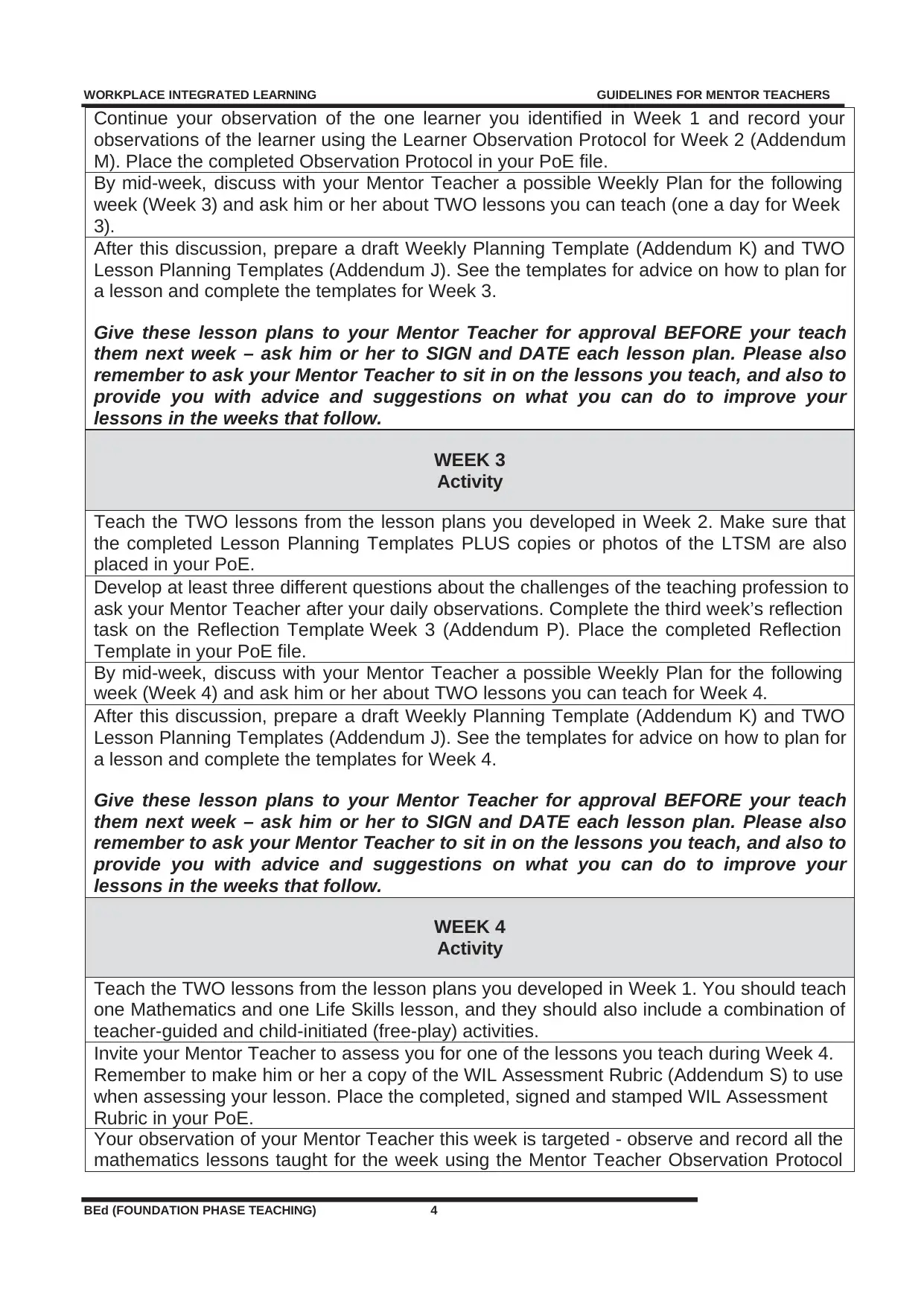
WORKPLACE INTEGRATED LEARNING GUIDELINES FOR MENTOR TEACHERS
BEd (FOUNDATION PHASE TEACHING) 4
Continue your observation of the one learner you identified in Week 1 and record your
observations of the learner using the Learner Observation Protocol for Week 2 (Addendum
M). Place the completed Observation Protocol in your PoE file.
By mid-week, discuss with your Mentor Teacher a possible Weekly Plan for the following
week (Week 3) and ask him or her about TWO lessons you can teach (one a day for Week
3).
After this discussion, prepare a draft Weekly Planning Template (Addendum K) and TWO
Lesson Planning Templates (Addendum J). See the templates for advice on how to plan for
a lesson and complete the templates for Week 3.
Give these lesson plans to your Mentor Teacher for approval BEFORE your teach
them next week – ask him or her to SIGN and DATE each lesson plan. Please also
remember to ask your Mentor Teacher to sit in on the lessons you teach, and also to
provide you with advice and suggestions on what you can do to improve your
lessons in the weeks that follow.
WEEK 3
Activity
Teach the TWO lessons from the lesson plans you developed in Week 2. Make sure that
the completed Lesson Planning Templates PLUS copies or photos of the LTSM are also
placed in your PoE.
Develop at least three different questions about the challenges of the teaching profession to
ask your Mentor Teacher after your daily observations. Complete the third week’s reflection
task on the Reflection Template Week 3 (Addendum P). Place the completed Reflection
Template in your PoE file.
By mid-week, discuss with your Mentor Teacher a possible Weekly Plan for the following
week (Week 4) and ask him or her about TWO lessons you can teach for Week 4.
After this discussion, prepare a draft Weekly Planning Template (Addendum K) and TWO
Lesson Planning Templates (Addendum J). See the templates for advice on how to plan for
a lesson and complete the templates for Week 4.
Give these lesson plans to your Mentor Teacher for approval BEFORE your teach
them next week – ask him or her to SIGN and DATE each lesson plan. Please also
remember to ask your Mentor Teacher to sit in on the lessons you teach, and also to
provide you with advice and suggestions on what you can do to improve your
lessons in the weeks that follow.
WEEK 4
Activity
Teach the TWO lessons from the lesson plans you developed in Week 1. You should teach
one Mathematics and one Life Skills lesson, and they should also include a combination of
teacher-guided and child-initiated (free-play) activities.
Invite your Mentor Teacher to assess you for one of the lessons you teach during Week 4.
Remember to make him or her a copy of the WIL Assessment Rubric (Addendum S) to use
when assessing your lesson. Place the completed, signed and stamped WIL Assessment
Rubric in your PoE.
Your observation of your Mentor Teacher this week is targeted - observe and record all the
mathematics lessons taught for the week using the Mentor Teacher Observation Protocol
BEd (FOUNDATION PHASE TEACHING) 4
Continue your observation of the one learner you identified in Week 1 and record your
observations of the learner using the Learner Observation Protocol for Week 2 (Addendum
M). Place the completed Observation Protocol in your PoE file.
By mid-week, discuss with your Mentor Teacher a possible Weekly Plan for the following
week (Week 3) and ask him or her about TWO lessons you can teach (one a day for Week
3).
After this discussion, prepare a draft Weekly Planning Template (Addendum K) and TWO
Lesson Planning Templates (Addendum J). See the templates for advice on how to plan for
a lesson and complete the templates for Week 3.
Give these lesson plans to your Mentor Teacher for approval BEFORE your teach
them next week – ask him or her to SIGN and DATE each lesson plan. Please also
remember to ask your Mentor Teacher to sit in on the lessons you teach, and also to
provide you with advice and suggestions on what you can do to improve your
lessons in the weeks that follow.
WEEK 3
Activity
Teach the TWO lessons from the lesson plans you developed in Week 2. Make sure that
the completed Lesson Planning Templates PLUS copies or photos of the LTSM are also
placed in your PoE.
Develop at least three different questions about the challenges of the teaching profession to
ask your Mentor Teacher after your daily observations. Complete the third week’s reflection
task on the Reflection Template Week 3 (Addendum P). Place the completed Reflection
Template in your PoE file.
By mid-week, discuss with your Mentor Teacher a possible Weekly Plan for the following
week (Week 4) and ask him or her about TWO lessons you can teach for Week 4.
After this discussion, prepare a draft Weekly Planning Template (Addendum K) and TWO
Lesson Planning Templates (Addendum J). See the templates for advice on how to plan for
a lesson and complete the templates for Week 4.
Give these lesson plans to your Mentor Teacher for approval BEFORE your teach
them next week – ask him or her to SIGN and DATE each lesson plan. Please also
remember to ask your Mentor Teacher to sit in on the lessons you teach, and also to
provide you with advice and suggestions on what you can do to improve your
lessons in the weeks that follow.
WEEK 4
Activity
Teach the TWO lessons from the lesson plans you developed in Week 1. You should teach
one Mathematics and one Life Skills lesson, and they should also include a combination of
teacher-guided and child-initiated (free-play) activities.
Invite your Mentor Teacher to assess you for one of the lessons you teach during Week 4.
Remember to make him or her a copy of the WIL Assessment Rubric (Addendum S) to use
when assessing your lesson. Place the completed, signed and stamped WIL Assessment
Rubric in your PoE.
Your observation of your Mentor Teacher this week is targeted - observe and record all the
mathematics lessons taught for the week using the Mentor Teacher Observation Protocol
⊘ This is a preview!⊘
Do you want full access?
Subscribe today to unlock all pages.

Trusted by 1+ million students worldwide
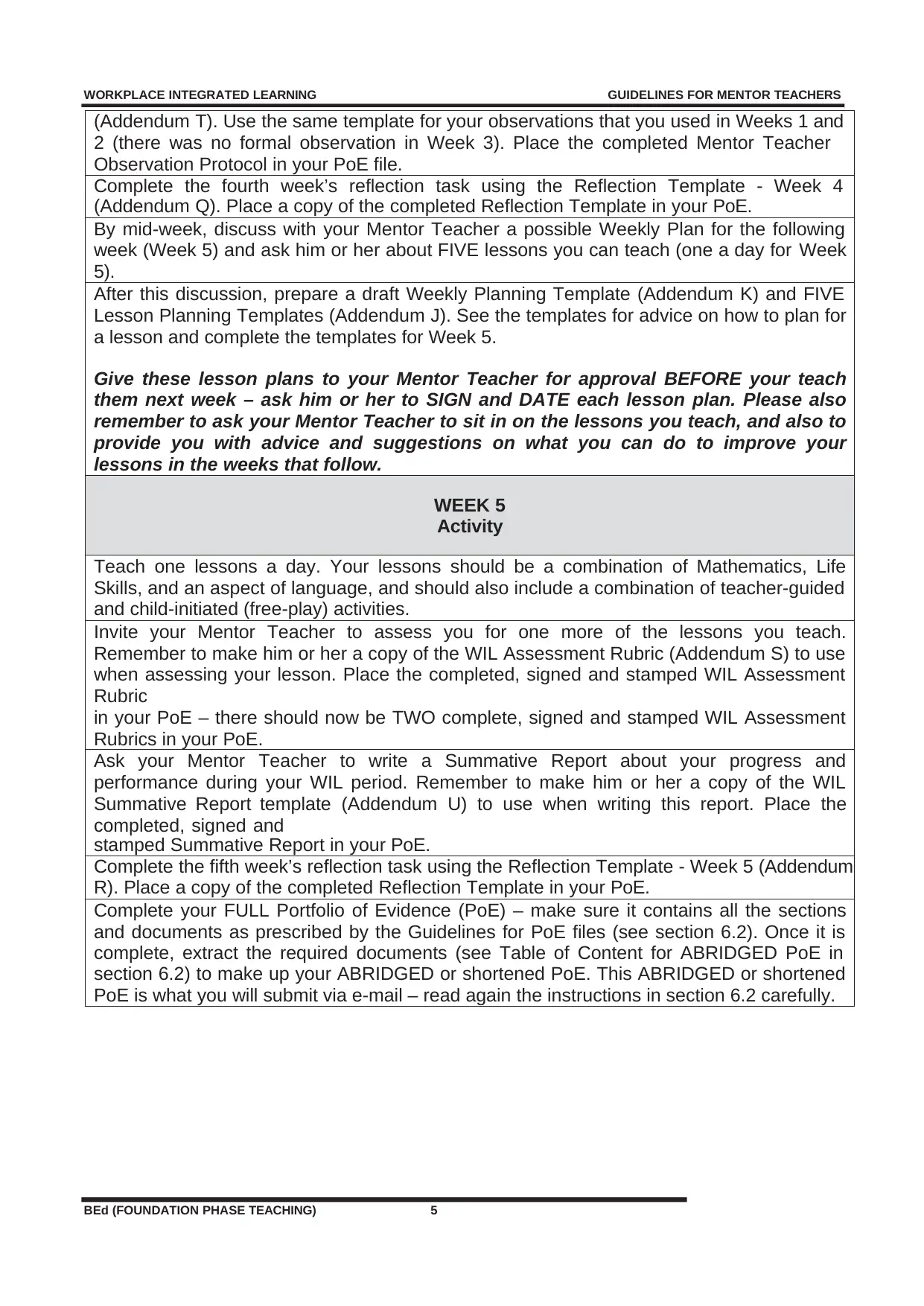
WORKPLACE INTEGRATED LEARNING GUIDELINES FOR MENTOR TEACHERS
BEd (FOUNDATION PHASE TEACHING) 5
(Addendum T). Use the same template for your observations that you used in Weeks 1 and
2 (there was no formal observation in Week 3). Place the completed Mentor Teacher
Observation Protocol in your PoE file.
Complete the fourth week’s reflection task using the Reflection Template - Week 4
(Addendum Q). Place a copy of the completed Reflection Template in your PoE.
By mid-week, discuss with your Mentor Teacher a possible Weekly Plan for the following
week (Week 5) and ask him or her about FIVE lessons you can teach (one a day for Week
5).
After this discussion, prepare a draft Weekly Planning Template (Addendum K) and FIVE
Lesson Planning Templates (Addendum J). See the templates for advice on how to plan for
a lesson and complete the templates for Week 5.
Give these lesson plans to your Mentor Teacher for approval BEFORE your teach
them next week – ask him or her to SIGN and DATE each lesson plan. Please also
remember to ask your Mentor Teacher to sit in on the lessons you teach, and also to
provide you with advice and suggestions on what you can do to improve your
lessons in the weeks that follow.
WEEK 5
Activity
Teach one lessons a day. Your lessons should be a combination of Mathematics, Life
Skills, and an aspect of language, and should also include a combination of teacher-guided
and child-initiated (free-play) activities.
Invite your Mentor Teacher to assess you for one more of the lessons you teach.
Remember to make him or her a copy of the WIL Assessment Rubric (Addendum S) to use
when assessing your lesson. Place the completed, signed and stamped WIL Assessment
Rubric
in your PoE – there should now be TWO complete, signed and stamped WIL Assessment
Rubrics in your PoE.
Ask your Mentor Teacher to write a Summative Report about your progress and
performance during your WIL period. Remember to make him or her a copy of the WIL
Summative Report template (Addendum U) to use when writing this report. Place the
completed, signed and
stamped Summative Report in your PoE.
Complete the fifth week’s reflection task using the Reflection Template - Week 5 (Addendum
R). Place a copy of the completed Reflection Template in your PoE.
Complete your FULL Portfolio of Evidence (PoE) – make sure it contains all the sections
and documents as prescribed by the Guidelines for PoE files (see section 6.2). Once it is
complete, extract the required documents (see Table of Content for ABRIDGED PoE in
section 6.2) to make up your ABRIDGED or shortened PoE. This ABRIDGED or shortened
PoE is what you will submit via e-mail – read again the instructions in section 6.2 carefully.
BEd (FOUNDATION PHASE TEACHING) 5
(Addendum T). Use the same template for your observations that you used in Weeks 1 and
2 (there was no formal observation in Week 3). Place the completed Mentor Teacher
Observation Protocol in your PoE file.
Complete the fourth week’s reflection task using the Reflection Template - Week 4
(Addendum Q). Place a copy of the completed Reflection Template in your PoE.
By mid-week, discuss with your Mentor Teacher a possible Weekly Plan for the following
week (Week 5) and ask him or her about FIVE lessons you can teach (one a day for Week
5).
After this discussion, prepare a draft Weekly Planning Template (Addendum K) and FIVE
Lesson Planning Templates (Addendum J). See the templates for advice on how to plan for
a lesson and complete the templates for Week 5.
Give these lesson plans to your Mentor Teacher for approval BEFORE your teach
them next week – ask him or her to SIGN and DATE each lesson plan. Please also
remember to ask your Mentor Teacher to sit in on the lessons you teach, and also to
provide you with advice and suggestions on what you can do to improve your
lessons in the weeks that follow.
WEEK 5
Activity
Teach one lessons a day. Your lessons should be a combination of Mathematics, Life
Skills, and an aspect of language, and should also include a combination of teacher-guided
and child-initiated (free-play) activities.
Invite your Mentor Teacher to assess you for one more of the lessons you teach.
Remember to make him or her a copy of the WIL Assessment Rubric (Addendum S) to use
when assessing your lesson. Place the completed, signed and stamped WIL Assessment
Rubric
in your PoE – there should now be TWO complete, signed and stamped WIL Assessment
Rubrics in your PoE.
Ask your Mentor Teacher to write a Summative Report about your progress and
performance during your WIL period. Remember to make him or her a copy of the WIL
Summative Report template (Addendum U) to use when writing this report. Place the
completed, signed and
stamped Summative Report in your PoE.
Complete the fifth week’s reflection task using the Reflection Template - Week 5 (Addendum
R). Place a copy of the completed Reflection Template in your PoE.
Complete your FULL Portfolio of Evidence (PoE) – make sure it contains all the sections
and documents as prescribed by the Guidelines for PoE files (see section 6.2). Once it is
complete, extract the required documents (see Table of Content for ABRIDGED PoE in
section 6.2) to make up your ABRIDGED or shortened PoE. This ABRIDGED or shortened
PoE is what you will submit via e-mail – read again the instructions in section 6.2 carefully.
Paraphrase This Document
Need a fresh take? Get an instant paraphrase of this document with our AI Paraphraser
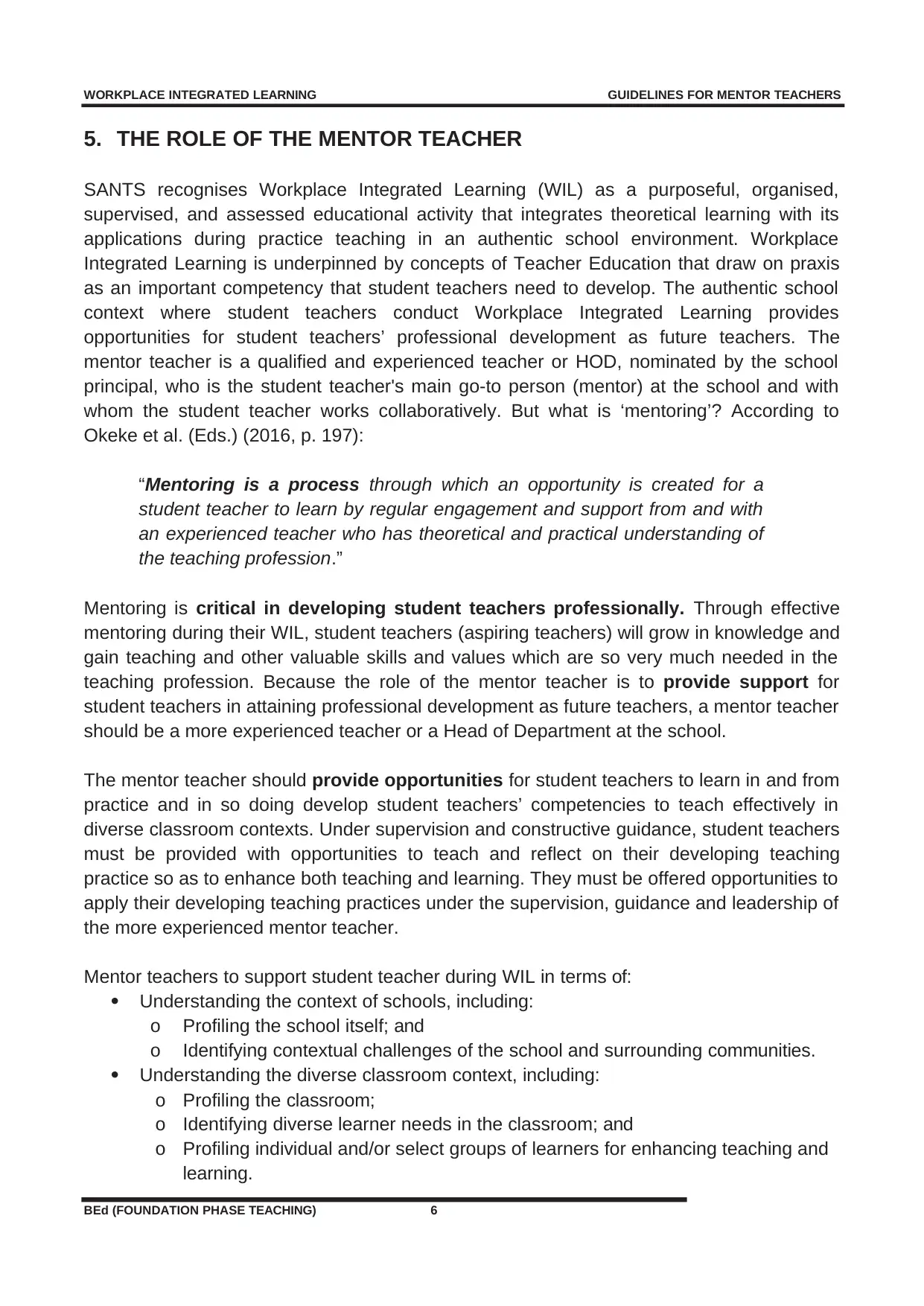
WORKPLACE INTEGRATED LEARNING GUIDELINES FOR MENTOR TEACHERS
BEd (FOUNDATION PHASE TEACHING) 6
5. THE ROLE OF THE MENTOR TEACHER
SANTS recognises Workplace Integrated Learning (WIL) as a purposeful, organised,
supervised, and assessed educational activity that integrates theoretical learning with its
applications during practice teaching in an authentic school environment. Workplace
Integrated Learning is underpinned by concepts of Teacher Education that draw on praxis
as an important competency that student teachers need to develop. The authentic school
context where student teachers conduct Workplace Integrated Learning provides
opportunities for student teachers’ professional development as future teachers. The
mentor teacher is a qualified and experienced teacher or HOD, nominated by the school
principal, who is the student teacher's main go-to person (mentor) at the school and with
whom the student teacher works collaboratively. But what is ‘mentoring’? According to
Okeke et al. (Eds.) (2016, p. 197):
“Mentoring is a process through which an opportunity is created for a
student teacher to learn by regular engagement and support from and with
an experienced teacher who has theoretical and practical understanding of
the teaching profession.”
Mentoring is critical in developing student teachers professionally. Through effective
mentoring during their WIL, student teachers (aspiring teachers) will grow in knowledge and
gain teaching and other valuable skills and values which are so very much needed in the
teaching profession. Because the role of the mentor teacher is to provide support for
student teachers in attaining professional development as future teachers, a mentor teacher
should be a more experienced teacher or a Head of Department at the school.
The mentor teacher should provide opportunities for student teachers to learn in and from
practice and in so doing develop student teachers’ competencies to teach effectively in
diverse classroom contexts. Under supervision and constructive guidance, student teachers
must be provided with opportunities to teach and reflect on their developing teaching
practice so as to enhance both teaching and learning. They must be offered opportunities to
apply their developing teaching practices under the supervision, guidance and leadership of
the more experienced mentor teacher.
Mentor teachers to support student teacher during WIL in terms of:
Understanding the context of schools, including:
o Profiling the school itself; and
o Identifying contextual challenges of the school and surrounding communities.
Understanding the diverse classroom context, including:
o Profiling the classroom;
o Identifying diverse learner needs in the classroom; and
o Profiling individual and/or select groups of learners for enhancing teaching and
learning.
BEd (FOUNDATION PHASE TEACHING) 6
5. THE ROLE OF THE MENTOR TEACHER
SANTS recognises Workplace Integrated Learning (WIL) as a purposeful, organised,
supervised, and assessed educational activity that integrates theoretical learning with its
applications during practice teaching in an authentic school environment. Workplace
Integrated Learning is underpinned by concepts of Teacher Education that draw on praxis
as an important competency that student teachers need to develop. The authentic school
context where student teachers conduct Workplace Integrated Learning provides
opportunities for student teachers’ professional development as future teachers. The
mentor teacher is a qualified and experienced teacher or HOD, nominated by the school
principal, who is the student teacher's main go-to person (mentor) at the school and with
whom the student teacher works collaboratively. But what is ‘mentoring’? According to
Okeke et al. (Eds.) (2016, p. 197):
“Mentoring is a process through which an opportunity is created for a
student teacher to learn by regular engagement and support from and with
an experienced teacher who has theoretical and practical understanding of
the teaching profession.”
Mentoring is critical in developing student teachers professionally. Through effective
mentoring during their WIL, student teachers (aspiring teachers) will grow in knowledge and
gain teaching and other valuable skills and values which are so very much needed in the
teaching profession. Because the role of the mentor teacher is to provide support for
student teachers in attaining professional development as future teachers, a mentor teacher
should be a more experienced teacher or a Head of Department at the school.
The mentor teacher should provide opportunities for student teachers to learn in and from
practice and in so doing develop student teachers’ competencies to teach effectively in
diverse classroom contexts. Under supervision and constructive guidance, student teachers
must be provided with opportunities to teach and reflect on their developing teaching
practice so as to enhance both teaching and learning. They must be offered opportunities to
apply their developing teaching practices under the supervision, guidance and leadership of
the more experienced mentor teacher.
Mentor teachers to support student teacher during WIL in terms of:
Understanding the context of schools, including:
o Profiling the school itself; and
o Identifying contextual challenges of the school and surrounding communities.
Understanding the diverse classroom context, including:
o Profiling the classroom;
o Identifying diverse learner needs in the classroom; and
o Profiling individual and/or select groups of learners for enhancing teaching and
learning.
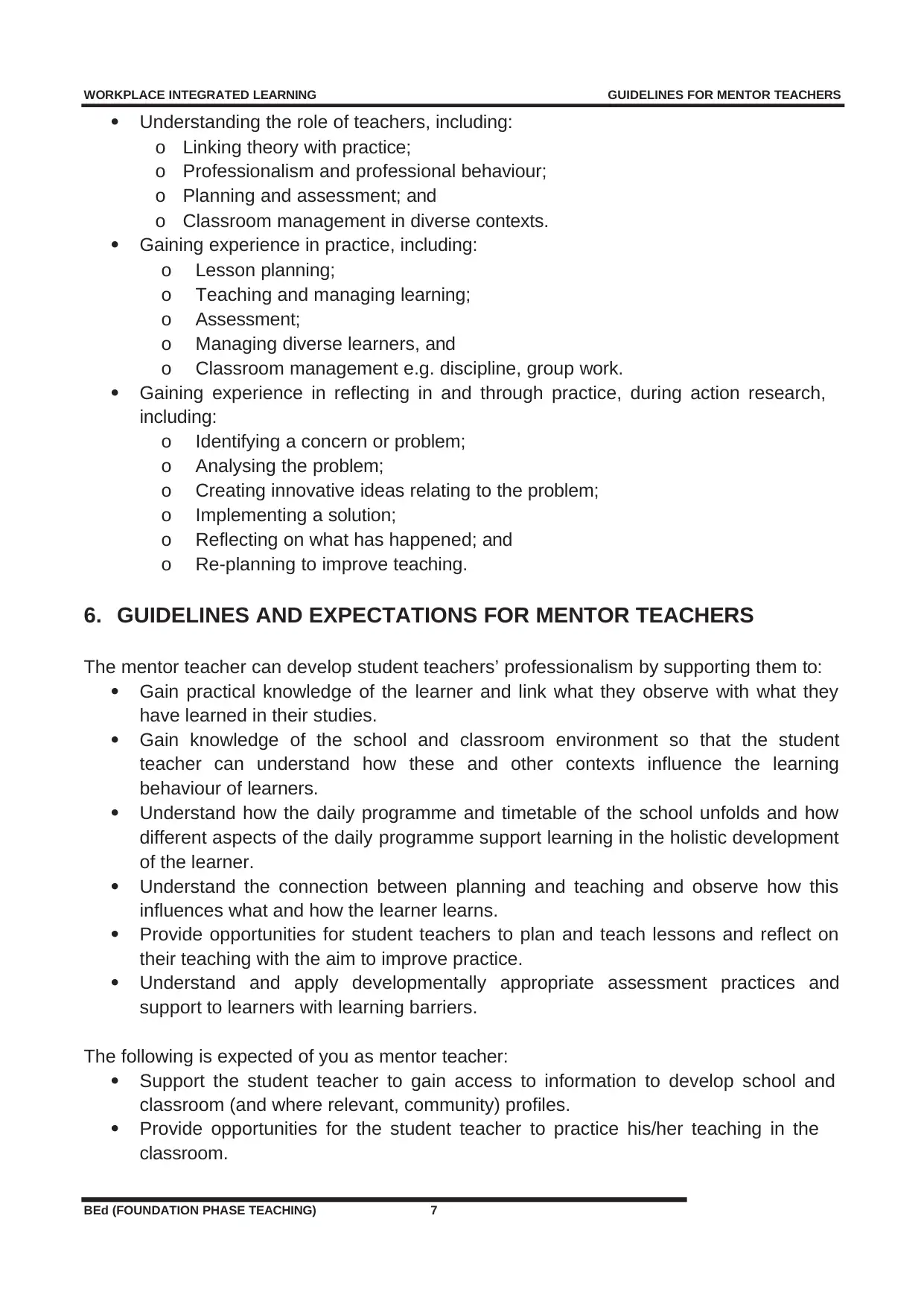
WORKPLACE INTEGRATED LEARNING GUIDELINES FOR MENTOR TEACHERS
BEd (FOUNDATION PHASE TEACHING) 7
Understanding the role of teachers, including:
o Linking theory with practice;
o Professionalism and professional behaviour;
o Planning and assessment; and
o Classroom management in diverse contexts.
Gaining experience in practice, including:
o Lesson planning;
o Teaching and managing learning;
o Assessment;
o Managing diverse learners, and
o Classroom management e.g. discipline, group work.
Gaining experience in reflecting in and through practice, during action research,
including:
o Identifying a concern or problem;
o Analysing the problem;
o Creating innovative ideas relating to the problem;
o Implementing a solution;
o Reflecting on what has happened; and
o Re-planning to improve teaching.
6. GUIDELINES AND EXPECTATIONS FOR MENTOR TEACHERS
The mentor teacher can develop student teachers’ professionalism by supporting them to:
Gain practical knowledge of the learner and link what they observe with what they
have learned in their studies.
Gain knowledge of the school and classroom environment so that the student
teacher can understand how these and other contexts influence the learning
behaviour of learners.
Understand how the daily programme and timetable of the school unfolds and how
different aspects of the daily programme support learning in the holistic development
of the learner.
Understand the connection between planning and teaching and observe how this
influences what and how the learner learns.
Provide opportunities for student teachers to plan and teach lessons and reflect on
their teaching with the aim to improve practice.
Understand and apply developmentally appropriate assessment practices and
support to learners with learning barriers.
The following is expected of you as mentor teacher:
Support the student teacher to gain access to information to develop school and
classroom (and where relevant, community) profiles.
Provide opportunities for the student teacher to practice his/her teaching in the
classroom.
BEd (FOUNDATION PHASE TEACHING) 7
Understanding the role of teachers, including:
o Linking theory with practice;
o Professionalism and professional behaviour;
o Planning and assessment; and
o Classroom management in diverse contexts.
Gaining experience in practice, including:
o Lesson planning;
o Teaching and managing learning;
o Assessment;
o Managing diverse learners, and
o Classroom management e.g. discipline, group work.
Gaining experience in reflecting in and through practice, during action research,
including:
o Identifying a concern or problem;
o Analysing the problem;
o Creating innovative ideas relating to the problem;
o Implementing a solution;
o Reflecting on what has happened; and
o Re-planning to improve teaching.
6. GUIDELINES AND EXPECTATIONS FOR MENTOR TEACHERS
The mentor teacher can develop student teachers’ professionalism by supporting them to:
Gain practical knowledge of the learner and link what they observe with what they
have learned in their studies.
Gain knowledge of the school and classroom environment so that the student
teacher can understand how these and other contexts influence the learning
behaviour of learners.
Understand how the daily programme and timetable of the school unfolds and how
different aspects of the daily programme support learning in the holistic development
of the learner.
Understand the connection between planning and teaching and observe how this
influences what and how the learner learns.
Provide opportunities for student teachers to plan and teach lessons and reflect on
their teaching with the aim to improve practice.
Understand and apply developmentally appropriate assessment practices and
support to learners with learning barriers.
The following is expected of you as mentor teacher:
Support the student teacher to gain access to information to develop school and
classroom (and where relevant, community) profiles.
Provide opportunities for the student teacher to practice his/her teaching in the
classroom.
⊘ This is a preview!⊘
Do you want full access?
Subscribe today to unlock all pages.

Trusted by 1+ million students worldwide
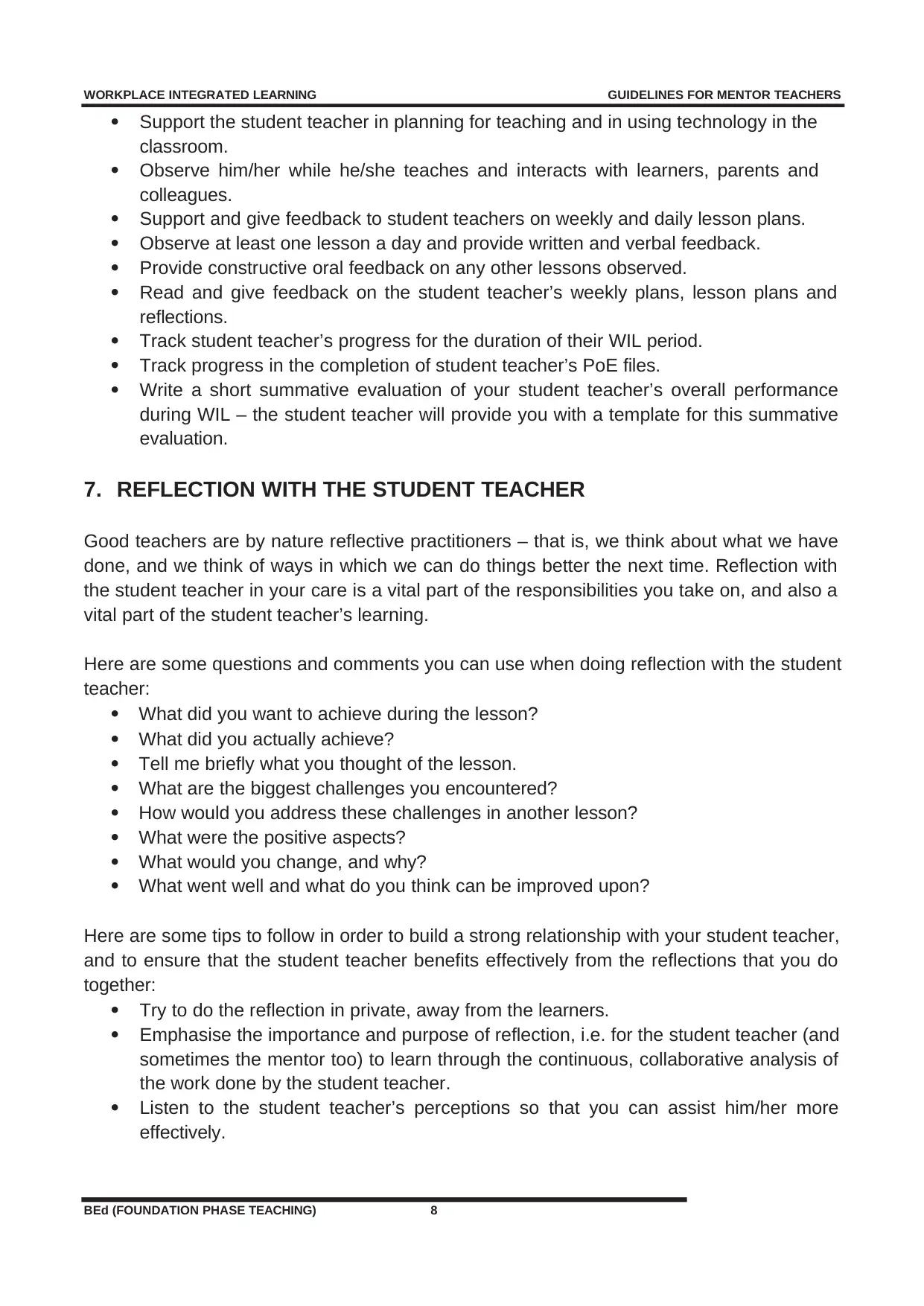
WORKPLACE INTEGRATED LEARNING GUIDELINES FOR MENTOR TEACHERS
BEd (FOUNDATION PHASE TEACHING) 8
Support the student teacher in planning for teaching and in using technology in the
classroom.
Observe him/her while he/she teaches and interacts with learners, parents and
colleagues.
Support and give feedback to student teachers on weekly and daily lesson plans.
Observe at least one lesson a day and provide written and verbal feedback.
Provide constructive oral feedback on any other lessons observed.
Read and give feedback on the student teacher’s weekly plans, lesson plans and
reflections.
Track student teacher’s progress for the duration of their WIL period.
Track progress in the completion of student teacher’s PoE files.
Write a short summative evaluation of your student teacher’s overall performance
during WIL – the student teacher will provide you with a template for this summative
evaluation.
7. REFLECTION WITH THE STUDENT TEACHER
Good teachers are by nature reflective practitioners – that is, we think about what we have
done, and we think of ways in which we can do things better the next time. Reflection with
the student teacher in your care is a vital part of the responsibilities you take on, and also a
vital part of the student teacher’s learning.
Here are some questions and comments you can use when doing reflection with the student
teacher:
What did you want to achieve during the lesson?
What did you actually achieve?
Tell me briefly what you thought of the lesson.
What are the biggest challenges you encountered?
How would you address these challenges in another lesson?
What were the positive aspects?
What would you change, and why?
What went well and what do you think can be improved upon?
Here are some tips to follow in order to build a strong relationship with your student teacher,
and to ensure that the student teacher benefits effectively from the reflections that you do
together:
Try to do the reflection in private, away from the learners.
Emphasise the importance and purpose of reflection, i.e. for the student teacher (and
sometimes the mentor too) to learn through the continuous, collaborative analysis of
the work done by the student teacher.
Listen to the student teacher’s perceptions so that you can assist him/her more
effectively.
BEd (FOUNDATION PHASE TEACHING) 8
Support the student teacher in planning for teaching and in using technology in the
classroom.
Observe him/her while he/she teaches and interacts with learners, parents and
colleagues.
Support and give feedback to student teachers on weekly and daily lesson plans.
Observe at least one lesson a day and provide written and verbal feedback.
Provide constructive oral feedback on any other lessons observed.
Read and give feedback on the student teacher’s weekly plans, lesson plans and
reflections.
Track student teacher’s progress for the duration of their WIL period.
Track progress in the completion of student teacher’s PoE files.
Write a short summative evaluation of your student teacher’s overall performance
during WIL – the student teacher will provide you with a template for this summative
evaluation.
7. REFLECTION WITH THE STUDENT TEACHER
Good teachers are by nature reflective practitioners – that is, we think about what we have
done, and we think of ways in which we can do things better the next time. Reflection with
the student teacher in your care is a vital part of the responsibilities you take on, and also a
vital part of the student teacher’s learning.
Here are some questions and comments you can use when doing reflection with the student
teacher:
What did you want to achieve during the lesson?
What did you actually achieve?
Tell me briefly what you thought of the lesson.
What are the biggest challenges you encountered?
How would you address these challenges in another lesson?
What were the positive aspects?
What would you change, and why?
What went well and what do you think can be improved upon?
Here are some tips to follow in order to build a strong relationship with your student teacher,
and to ensure that the student teacher benefits effectively from the reflections that you do
together:
Try to do the reflection in private, away from the learners.
Emphasise the importance and purpose of reflection, i.e. for the student teacher (and
sometimes the mentor too) to learn through the continuous, collaborative analysis of
the work done by the student teacher.
Listen to the student teacher’s perceptions so that you can assist him/her more
effectively.
Paraphrase This Document
Need a fresh take? Get an instant paraphrase of this document with our AI Paraphraser
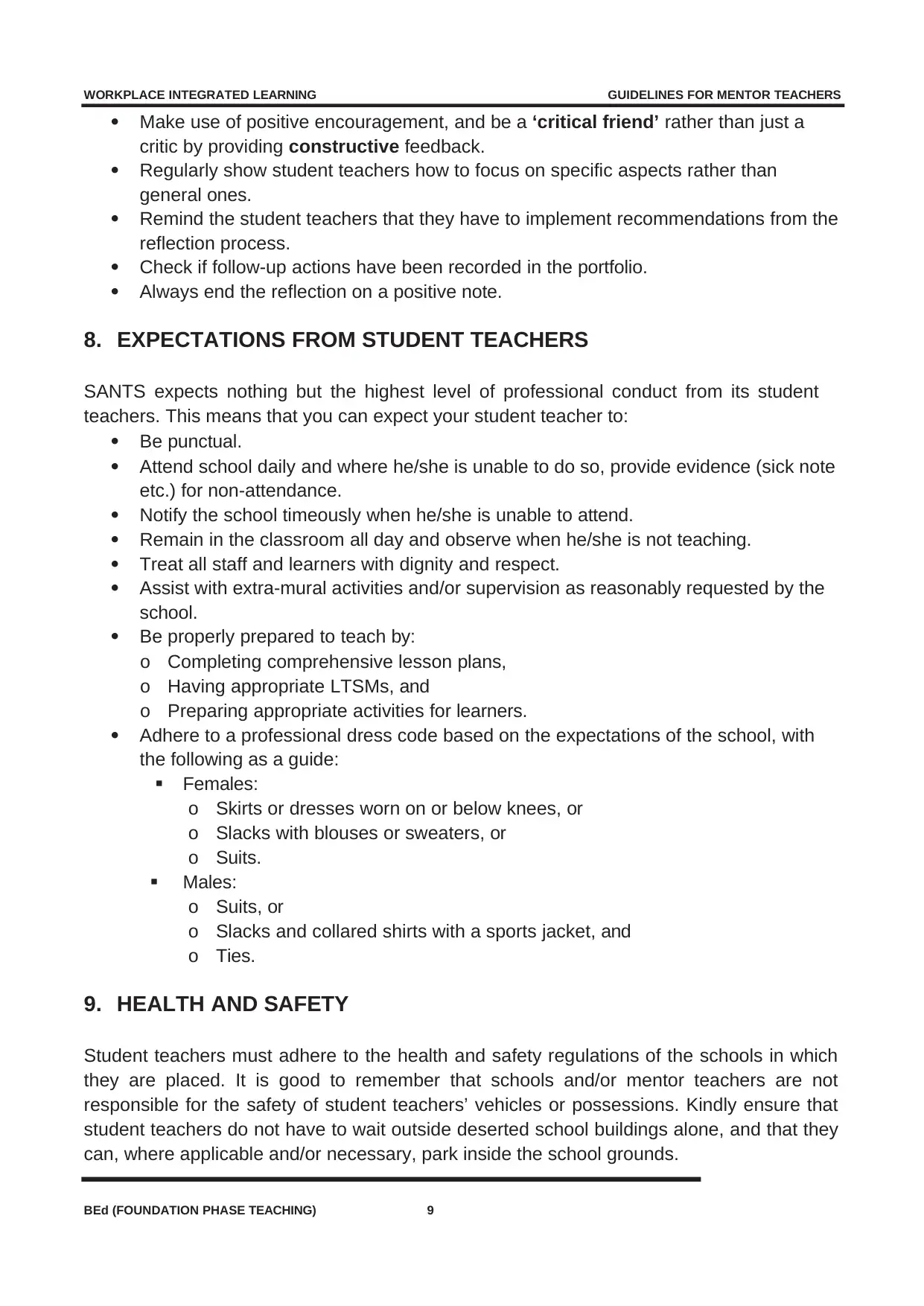
WORKPLACE INTEGRATED LEARNING GUIDELINES FOR MENTOR TEACHERS
BEd (FOUNDATION PHASE TEACHING) 9
Make use of positive encouragement, and be a ‘critical friend’ rather than just a
critic by providing constructive feedback.
Regularly show student teachers how to focus on specific aspects rather than
general ones.
Remind the student teachers that they have to implement recommendations from the
reflection process.
Check if follow-up actions have been recorded in the portfolio.
Always end the reflection on a positive note.
8. EXPECTATIONS FROM STUDENT TEACHERS
SANTS expects nothing but the highest level of professional conduct from its student
teachers. This means that you can expect your student teacher to:
Be punctual.
Attend school daily and where he/she is unable to do so, provide evidence (sick note
etc.) for non-attendance.
Notify the school timeously when he/she is unable to attend.
Remain in the classroom all day and observe when he/she is not teaching.
Treat all staff and learners with dignity and respect.
Assist with extra-mural activities and/or supervision as reasonably requested by the
school.
Be properly prepared to teach by:
o Completing comprehensive lesson plans,
o Having appropriate LTSMs, and
o Preparing appropriate activities for learners.
Adhere to a professional dress code based on the expectations of the school, with
the following as a guide:
Females:
o Skirts or dresses worn on or below knees, or
o Slacks with blouses or sweaters, or
o Suits.
Males:
o Suits, or
o Slacks and collared shirts with a sports jacket, and
o Ties.
9. HEALTH AND SAFETY
Student teachers must adhere to the health and safety regulations of the schools in which
they are placed. It is good to remember that schools and/or mentor teachers are not
responsible for the safety of student teachers’ vehicles or possessions. Kindly ensure that
student teachers do not have to wait outside deserted school buildings alone, and that they
can, where applicable and/or necessary, park inside the school grounds.
BEd (FOUNDATION PHASE TEACHING) 9
Make use of positive encouragement, and be a ‘critical friend’ rather than just a
critic by providing constructive feedback.
Regularly show student teachers how to focus on specific aspects rather than
general ones.
Remind the student teachers that they have to implement recommendations from the
reflection process.
Check if follow-up actions have been recorded in the portfolio.
Always end the reflection on a positive note.
8. EXPECTATIONS FROM STUDENT TEACHERS
SANTS expects nothing but the highest level of professional conduct from its student
teachers. This means that you can expect your student teacher to:
Be punctual.
Attend school daily and where he/she is unable to do so, provide evidence (sick note
etc.) for non-attendance.
Notify the school timeously when he/she is unable to attend.
Remain in the classroom all day and observe when he/she is not teaching.
Treat all staff and learners with dignity and respect.
Assist with extra-mural activities and/or supervision as reasonably requested by the
school.
Be properly prepared to teach by:
o Completing comprehensive lesson plans,
o Having appropriate LTSMs, and
o Preparing appropriate activities for learners.
Adhere to a professional dress code based on the expectations of the school, with
the following as a guide:
Females:
o Skirts or dresses worn on or below knees, or
o Slacks with blouses or sweaters, or
o Suits.
Males:
o Suits, or
o Slacks and collared shirts with a sports jacket, and
o Ties.
9. HEALTH AND SAFETY
Student teachers must adhere to the health and safety regulations of the schools in which
they are placed. It is good to remember that schools and/or mentor teachers are not
responsible for the safety of student teachers’ vehicles or possessions. Kindly ensure that
student teachers do not have to wait outside deserted school buildings alone, and that they
can, where applicable and/or necessary, park inside the school grounds.
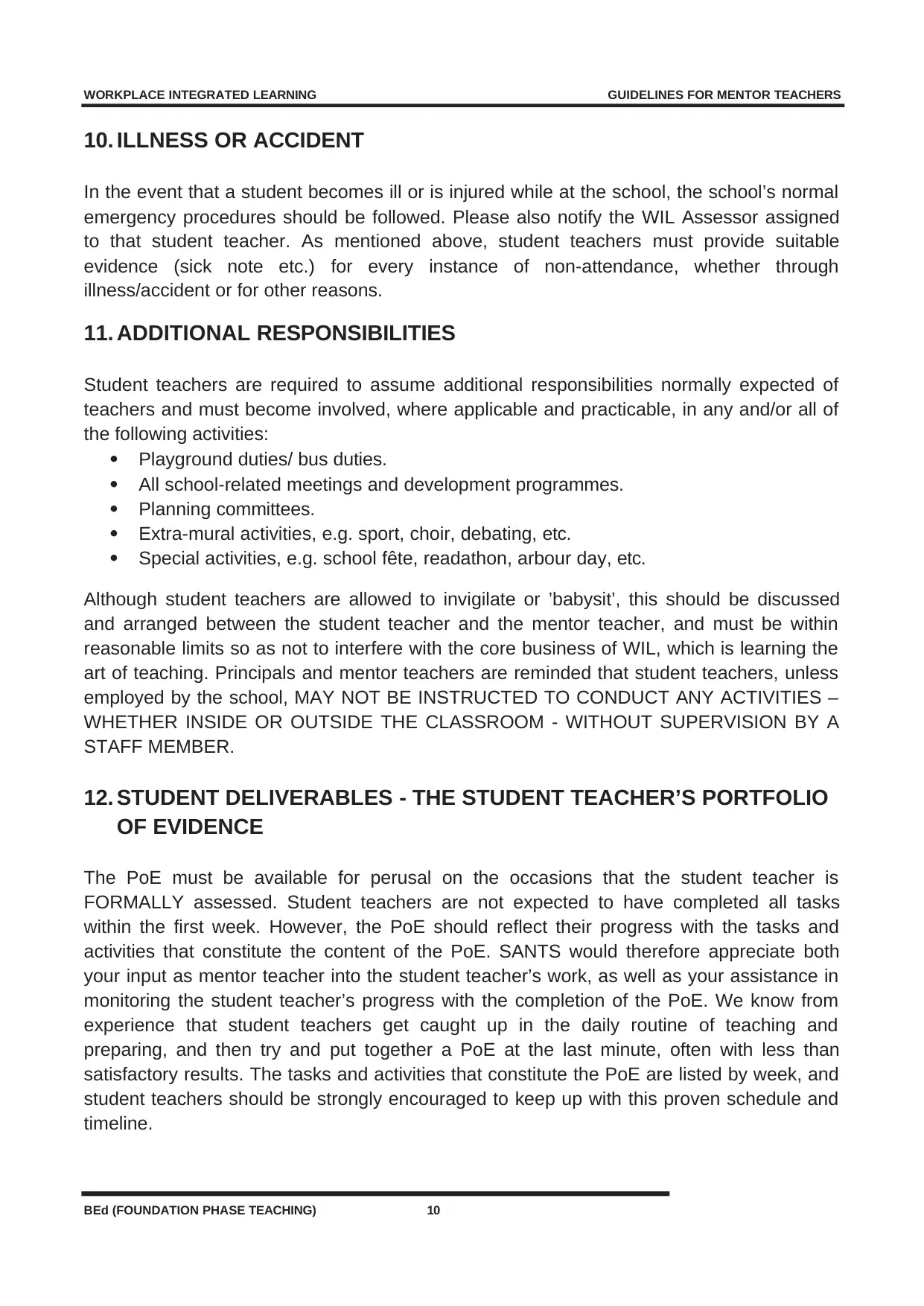
WORKPLACE INTEGRATED LEARNING GUIDELINES FOR MENTOR TEACHERS
BEd (FOUNDATION PHASE TEACHING) 10
10. ILLNESS OR ACCIDENT
In the event that a student becomes ill or is injured while at the school, the school’s normal
emergency procedures should be followed. Please also notify the WIL Assessor assigned
to that student teacher. As mentioned above, student teachers must provide suitable
evidence (sick note etc.) for every instance of non-attendance, whether through
illness/accident or for other reasons.
11. ADDITIONAL RESPONSIBILITIES
Student teachers are required to assume additional responsibilities normally expected of
teachers and must become involved, where applicable and practicable, in any and/or all of
the following activities:
Playground duties/ bus duties.
All school-related meetings and development programmes.
Planning committees.
Extra-mural activities, e.g. sport, choir, debating, etc.
Special activities, e.g. school fête, readathon, arbour day, etc.
Although student teachers are allowed to invigilate or ’babysit’, this should be discussed
and arranged between the student teacher and the mentor teacher, and must be within
reasonable limits so as not to interfere with the core business of WIL, which is learning the
art of teaching. Principals and mentor teachers are reminded that student teachers, unless
employed by the school, MAY NOT BE INSTRUCTED TO CONDUCT ANY ACTIVITIES –
WHETHER INSIDE OR OUTSIDE THE CLASSROOM - WITHOUT SUPERVISION BY A
STAFF MEMBER.
12. STUDENT DELIVERABLES - THE STUDENT TEACHER’S PORTFOLIO
OF EVIDENCE
The PoE must be available for perusal on the occasions that the student teacher is
FORMALLY assessed. Student teachers are not expected to have completed all tasks
within the first week. However, the PoE should reflect their progress with the tasks and
activities that constitute the content of the PoE. SANTS would therefore appreciate both
your input as mentor teacher into the student teacher’s work, as well as your assistance in
monitoring the student teacher’s progress with the completion of the PoE. We know from
experience that student teachers get caught up in the daily routine of teaching and
preparing, and then try and put together a PoE at the last minute, often with less than
satisfactory results. The tasks and activities that constitute the PoE are listed by week, and
student teachers should be strongly encouraged to keep up with this proven schedule and
timeline.
BEd (FOUNDATION PHASE TEACHING) 10
10. ILLNESS OR ACCIDENT
In the event that a student becomes ill or is injured while at the school, the school’s normal
emergency procedures should be followed. Please also notify the WIL Assessor assigned
to that student teacher. As mentioned above, student teachers must provide suitable
evidence (sick note etc.) for every instance of non-attendance, whether through
illness/accident or for other reasons.
11. ADDITIONAL RESPONSIBILITIES
Student teachers are required to assume additional responsibilities normally expected of
teachers and must become involved, where applicable and practicable, in any and/or all of
the following activities:
Playground duties/ bus duties.
All school-related meetings and development programmes.
Planning committees.
Extra-mural activities, e.g. sport, choir, debating, etc.
Special activities, e.g. school fête, readathon, arbour day, etc.
Although student teachers are allowed to invigilate or ’babysit’, this should be discussed
and arranged between the student teacher and the mentor teacher, and must be within
reasonable limits so as not to interfere with the core business of WIL, which is learning the
art of teaching. Principals and mentor teachers are reminded that student teachers, unless
employed by the school, MAY NOT BE INSTRUCTED TO CONDUCT ANY ACTIVITIES –
WHETHER INSIDE OR OUTSIDE THE CLASSROOM - WITHOUT SUPERVISION BY A
STAFF MEMBER.
12. STUDENT DELIVERABLES - THE STUDENT TEACHER’S PORTFOLIO
OF EVIDENCE
The PoE must be available for perusal on the occasions that the student teacher is
FORMALLY assessed. Student teachers are not expected to have completed all tasks
within the first week. However, the PoE should reflect their progress with the tasks and
activities that constitute the content of the PoE. SANTS would therefore appreciate both
your input as mentor teacher into the student teacher’s work, as well as your assistance in
monitoring the student teacher’s progress with the completion of the PoE. We know from
experience that student teachers get caught up in the daily routine of teaching and
preparing, and then try and put together a PoE at the last minute, often with less than
satisfactory results. The tasks and activities that constitute the PoE are listed by week, and
student teachers should be strongly encouraged to keep up with this proven schedule and
timeline.
⊘ This is a preview!⊘
Do you want full access?
Subscribe today to unlock all pages.

Trusted by 1+ million students worldwide
1 out of 52
Your All-in-One AI-Powered Toolkit for Academic Success.
+13062052269
info@desklib.com
Available 24*7 on WhatsApp / Email
![[object Object]](/_next/static/media/star-bottom.7253800d.svg)
Unlock your academic potential
Copyright © 2020–2025 A2Z Services. All Rights Reserved. Developed and managed by ZUCOL.